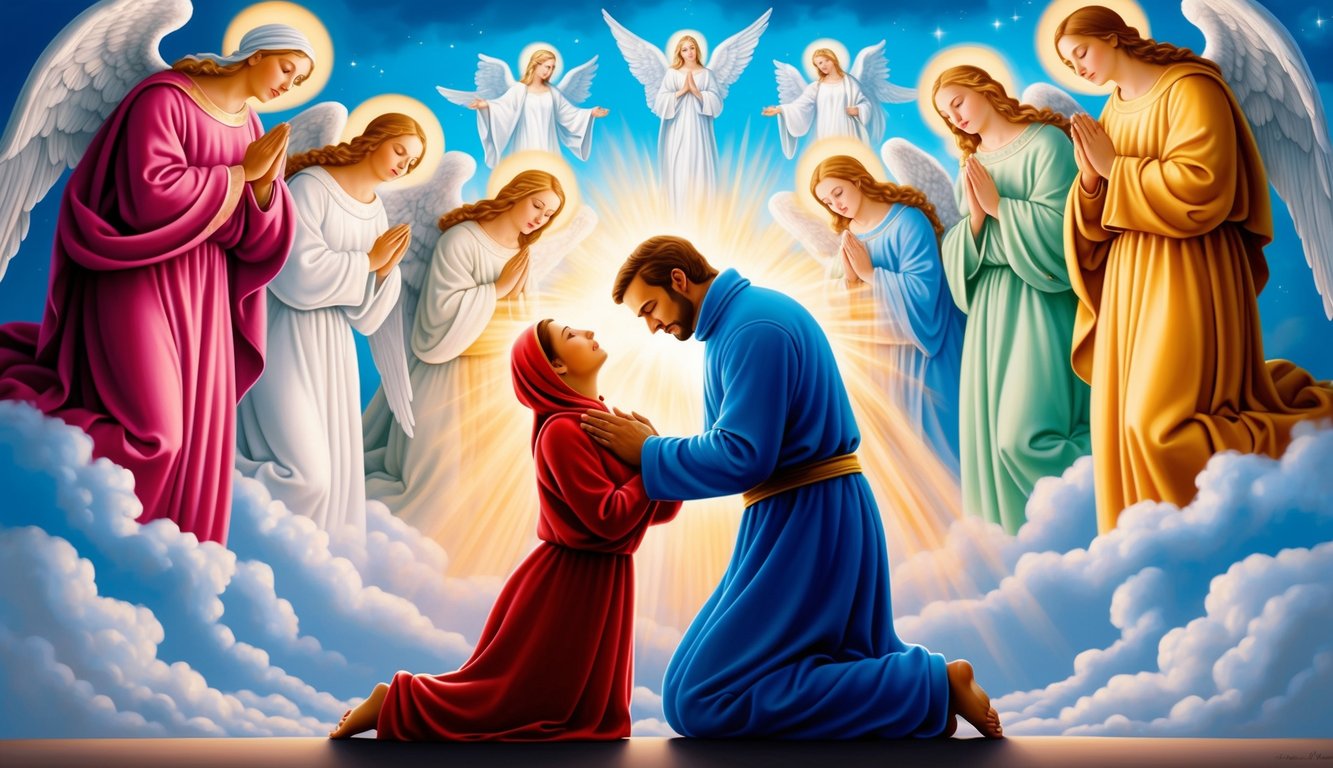Don’t Miss Out On This Unique Astrological Opportunity
Are you tired of spinning your wheels and getting nowhere? Simply put, you’re out of sync: you’re out of alignment with your astral configuration.
But: there’s a kind of map that can help you reclaim your alignment. Think of it as your own personal blueprint to success and happiness: a blueprint that will help you live your most amazing life.
Get started here.
Daniel 9 is a fascinating chapter that offers a deep dive into ancient prophecy and prayer. The chapter is most notable for Daniel’s prayer and the prophecy of the seventy weeks.
Many interpret this prophecy as relating to the coming of the Messiah. Readers are often drawn to Daniel’s intense devotion and the insight provided into divine plans.
Within this chapter, you encounter a blend of history and future predictions, set against the backdrop of Babylonian captivity.
Daniel’s prayers reflect genuine humility and a hope for his people’s redemption.
His earnest pleas reveal much about human nature and the quest for understanding divine intentions.
These intriguing themes make Daniel 9 a cornerstone for those interested in prophetic literature.
By exploring its layers, you gain insights not only into biblical events but also into how these narratives continue to shape beliefs today.
Key Takeaways
- Daniel 9 is known for its prayers and prophecies.
- Daniel’s prayer reveals human quests for divine insight.
- Understanding Daniel 9 offers insights into biblical prophecy.
Historical Context of Daniel 9
In Daniel 9, the narrative unfolds against a backdrop of historical and political change.
It involves significant events and figures like Daniel, Darius the Mede, and Jeremiah the prophet.
Understanding the timeline, key figures, and political climate of Judah and Babylon offers a clearer picture of its context.
Timeline of Events
The events in Daniel 9 occur during the Babylonian Exile, a period when the people of Judah were taken captive by the Babylonians.
King Nebuchadnezzar had conquered Judah around 605 BC, marking the beginning of this exile.
The chapter mentions the “seventy years” prophecy, referring to the duration of the exile as foretold by Jeremiah the prophet.
This prophecy predicted the eventual return of the people of Judah to their homeland.
The time described in Daniel 9 is during the first year of the reign of Darius the Mede.
Darius’ rule came after the fall of Babylon to the Persian Empire in 539 BC.
This timeline sets the stage for Daniel’s prayer and visions, centered on the prophecy’s fulfillment.
Key Figures: Daniel, Darius, and Jeremiah
Daniel is a wise and devoted servant of God, living in exile.
Known for his interpretations of dreams and visions, he plays a central role in the book bearing his name.
In chapter 9, Daniel is seen praying and seeking understanding of the prophecy given by Jeremiah the prophet.
Darius the Mede is portrayed as the ruler who succeeded the Babylonian king Belshazzar.
His reign marks a change in the political leadership influencing Daniel’s experiences and prophecies.
Jeremiah the prophet was a major figure whose prophecies are central to the narrative.
His words about the seventy years are crucial to Daniel’s prayers and reflections.
Jeremiah’s influence is significant, providing a backdrop for the unfolding events.
The Political Climate of Judah and Babylon
During the time of Daniel 9, Judah was under Babylonian control, having been captured by Nebuchadnezzar.
The people of the land, including Daniel, were taken into exile, which drastically shifted the region’s dynamics.
The political scene changed with the rise of the Persian Empire, as King Cyrus and Darius the Mede took control.
The fall of Babylon meant new policies and possibilities for the Jewish exiles living there.
Persian rule was often more tolerant toward different cultures and religions, influencing the rebuilding efforts in Jerusalem, fulfilling Jeremiah’s prophecy.
The shifts in power and governance had a profound impact on Judah and the surrounding regions, reshaping their future.
The Prayer of Daniel
In the Book of Daniel, his prayer is a heartfelt plea reflecting themes of sin, repentance, and seeking God’s mercy.
This prayer is notable for its emphasis on confession and the symbolic acts that accompany it.
Acknowledgement of Sin and Plea for Mercy
In Daniel’s prayer, you see a deep acknowledgment of sin.
He explicitly confesses the sins of Israel, addressing the Lord with a plea for mercy.
Recognizing the wickedness and transgressions committed, Daniel emphasizes how the people have repeatedly rebelled against the commandments and the laws given by God.
Daniel points out that despite the righteousness of the Lord, Israel has faced shame because of their unfaithfulness.
The prayer reflects on the curse and oath written in the law of Moses, showing awareness of the consequences of rebellion.
By admitting guilt, Daniel seeks forgiveness not just for himself but also for the whole nation, urging divine mercy over righteous judgment.
The Role of Fasting, Sackcloth, and Ashes
The prayer includes significant elements of fasting, sackcloth, and ashes, all symbols of humility and penance.
Fasting showcases a deep commitment to seeking the Lord’s favor, setting aside physical needs to focus on spiritual matters.
Sackcloth and ashes are traditional signs of mourning and repentance, vividly displaying the gravity of sin and the earnest desire to return to righteousness.
These actions express deep sorrow over past transgressions and signify a sincere intention to change.
By adopting such practices, Daniel aligns himself with the ancient traditions of seeking God’s compassion through visible acts of repentance, demonstrating both personal commitment and solidarity with his people’s plight.
Covenant and Commandments
Daniel’s prayer intricately ties to the covenant and commandments.
You see Daniel referencing the established covenant between God and Israel, highlighting how the people have failed to adhere to the laws set by the servants of God, the prophets.
This breach has led to the tragic state of the holy city and the people of the land.
The prayer asks for God’s steadfast love to remember His covenant despite past unfaithfulness.
Daniel underscores the hope that comes from God’s promises, banking on divine mercy and righteousness to restore the sanctuary and lift the shame that has fallen upon the people.
This plea for compassion is aimed at reviving both spiritual and communal integrity.
Daniel’s supplication reflects the deep yearning for renewal, emphasizing that redemption is possible even in the face of past transgressions.
It is in these moments of sincere repentance that divine grace becomes most evident, revealing how restoration unfolds when faith heals.
Through this heartfelt appeal, the prayer becomes a testament to the transformative power of trust in God’s unwavering love.
Prophetic Visions and Interpretations

In Daniel 9, a profound vision is presented, revealing significant prophecies about the anointed one and events shaping the future.
These insights are delivered through the angel Gabriel, offering interpretations that include the seventy weeks, the appearance of the prince, and the impending challenges for the city and sanctuary.
The Seventy Weeks Prophecy
Gabriel informs Daniel of the prophecy involving seventy weeks, a period marked by profound events.
This prophecy outlines critical moments like the rebuilding of Jerusalem and the coming of an anointed ruler.
During this time, efforts will be made to end sin, establish everlasting righteousness, and confirm visions and prophecies received from the Lord.
The seventy weeks are divided into smaller segments, each marking significant developments in the path to righteousness, with the seventy years mentioned by Jeremiah the prophet providing context for these events.
Revelation of the Anointed One and the Prince
As the prophecy unfolds, it reveals the coming of an anointed one, essential for the realization of divine plans.
This figure emerges during a troubled time but signifies hope for the people.
A prince will also play a crucial role, leading to the rebuilding efforts in Jerusalem.
This period is challenged by the appearance of abominations, signaling great upheaval.
Sacrifices and offerings will be curtailed, reflecting on the overarching tension between the sacred and profane, testing the inhabitants’ faith and the city’s resilience amidst growing desolation.
The Closing of the Vision: A Future set in Mystery
The closing of this vision encapsulates a future laced with uncertainty.
The prophecy concludes with predictions of desolation and destruction that will test Jerusalem’s people.
The holy mountain remains a focal point, with the prophecy extending to the end of time itself.
This period, marked by the concept of abominations, calls for reflection and redemption.
The temple, city, and sanctuary undergo trials, while the inhabitants are urged to atone for their sins to avert disaster and restore their connection with the divine ordains.
These revelations prompt deeper insight into the judgments delivered through the ages, calling believers to act, adhere to the law, and seek sanctuary in the word of the Lord.
Frequently Asked Questions

Daniel chapter 9 is an important biblical text that includes themes of prayer, prophecy, and repentance.
It offers insights into Daniel’s historical setting and his visions, which continue to be relevant in religious discussions today.
What is the historical context of Daniel chapter 9?
Daniel chapter 9 is set during the time of exile for the Jewish people in Babylon.
The chapter highlights Daniel’s response to prophecies from Jeremiah, which speak of a seventy-year period of desolation for Jerusalem.
How is Daniel’s prayer in chapter 9 relevant to contemporary faith practices?
Daniel’s prayer shows a deep connection with God, highlighting themes of confession and seeking forgiveness.
This is similar to practices today where prayer is used to seek guidance and show devotion.
The prayer reflects a desire for restoration and fulfillment of promises.
What is the significance of the seventy weeks prophecy in Daniel 9?
The seventy weeks prophecy is a key element that refers to a future timeline leading to the restoration of Jerusalem.
It is often seen as a prophecy about important events affecting both the Jewish people and the broader religious community, marking critical periods and transitions in biblical history.
How have interpretations of the ‘abomination of desolation’ mentioned in Daniel 9 evolved over time?
The ‘abomination of desolation’ has been a subject of varying interpretations.
It is traditionally understood as a reference to a desecration event in the temple.
Over time, it has been linked to different historical and future events, reflecting the changing perspectives on biblical prophecy.
What role does repentance play in Daniel’s narrative in chapter 9?
Repentance is central to Daniel’s prayer, as he pleads with God for mercy and forgiveness for his people’s sins.
This act of repentance underscores a fundamental theme of returning to God and seeking His favor, which remains significant in religious teachings on repentance.
How does Daniel 9 connect to the overall themes of the Book of Daniel?
Daniel 9 fits into the Book of Daniel by continuing themes of faithfulness, prophecy, and divine intervention.
The chapter enriches the narrative of Daniel’s visions and his role as a mediator between God and the Jewish people.
It ties in with earlier accounts of trials and deliverance.



